
A nebula is a distinct luminescent part of interstellar medium, which can consist of ionized, neutral, or molecular hydrogen and also cosmic dust. Nebulae are often star-forming regions, such as in the "Pillars of Creation" in the Eagle Nebula. In these regions, the formations of gas, dust, and other materials "clump" together to form denser regions, which attract further matter and eventually become dense enough to form stars. The remaining material is then thought to form planets and other planetary system objects. However, scientifically, it is unclear as to where the original matter came from; as energy is not created or destroyed.

A planetary nebula is a type of emission nebula consisting of an expanding, glowing shell of ionized gas ejected from red giant stars late in their lives.

The Ring Nebula is a planetary nebula in the northern constellation of Lyra. Such a nebula is formed when a star, during the last stages of its evolution before becoming a white dwarf, expels a vast luminous envelope of ionized gas into the surrounding interstellar space.

The Orion Nebula is a diffuse nebula situated in the Milky Way, being south of Orion's Belt in the constellation of Orion, and is known as the middle "star" in the "sword" of Orion. It is one of the brightest nebulae and is visible to the naked eye in the night sky with apparent magnitude 4.0. It is 1,344 ± 20 light-years (412.1 ± 6.1 pc) away and is the closest region of massive star formation to Earth. The M42 nebula is estimated to be 24 light-years across. It has a mass of about 2,000 times that of the Sun. Older texts frequently refer to the Orion Nebula as the Great Nebula in Orion or the Great Orion Nebula.
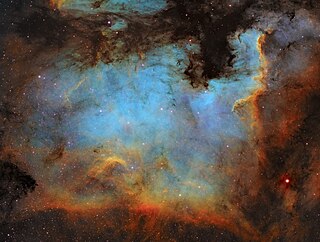
The North America Nebula is an emission nebula in the constellation Cygnus, close to Deneb. It is named because its shape resembles North America.

The Eskimo Nebula, also known as the Clown-faced Nebula, Lion Nebula, or Caldwell 39, is a bipolar double-shell planetary nebula (PN). It was discovered by astronomer William Herschel in 1787. The formation resembles a person's head surrounded by a parka hood. It is surrounded by gas that composed the outer layers of a Sun-like star. The visible inner filaments are ejected by a strong wind of particles from the central star. The outer disk contains unusual, light-year-long filaments.
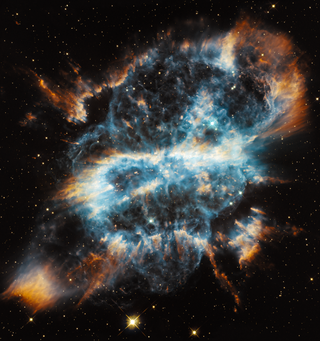
NGC 5189 is a planetary nebula in the constellation Musca. It was discovered by James Dunlop on 1 July 1826, who catalogued it as Δ252. For many years, well into the 1960s, it was thought to be a bright emission nebula. It was Karl Gordon Henize in 1967 who first described NGC 5189 as quasi-planetary based on its spectral emissions.

Sh2-279 is an HII region and bright nebulae that includes a reflection nebula located in the constellation Orion. It is the northernmost part of the asterism known as Orion's Sword, lying 0.6° north of the Orion Nebula. The reflection nebula embedded in Sh2-279 is popularly known as the Running Man Nebula.

NGC 6751, also known as the Glowing Eye Nebula or the Dandelion Puffball Nebula, is a planetary nebula in the constellation Aquila. It is estimated to be about 6,500 light-years away.
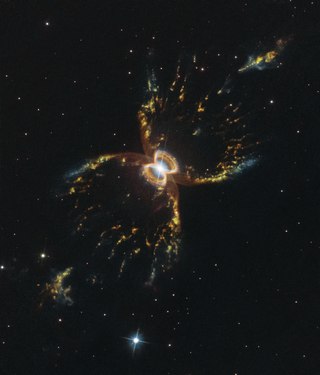
The Southern Crab Nebula is a nebula in the constellation Centaurus. The nebula is several thousand light years from Earth, and its central star is a symbiotic Mira variable - white dwarf pair. It is named for its resemblance to the Crab Nebula, which is in the northern sky.
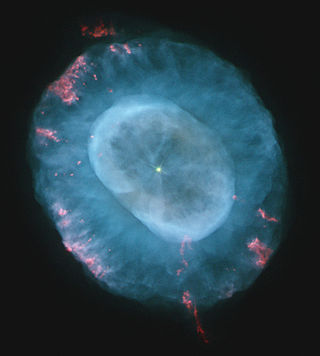
NGC 7662 is a planetary nebula located in the northern constellation Andromeda. It is known as the Blue Snowball Nebula, Snowball Nebula, and Caldwell 22. This nebula was discovered October 6, 1784 by the German-born English astronomer William Herschel. In the New General Catalogue it is described as a "magnificent planetary or annular nebula, very bright, pretty small in angular size, round, blue, variable nucleus". The object has an apparent visual magnitude of 8.3 and spans an angular size of 32″ × 28″. Parallax measurements give a distance estimate of 5,730 ± 340 ly (1,757 ± 103 pc).

NGC 6884 is a planetary nebula located in the constellation Cygnus, less than a degree to the southwest of the star Ο1 Cygni. It lies at a distance of approximately 12.5 kly from the Sun. The nebula was discovered on May 8, 1883, by American astronomer Edward C. Pickering.
The Orion space telescopes were a series of two instruments flown aboard Soviet spacecraft during the 1970s to conduct ultraviolet spectroscopy of stars.

IC 405 is an emission and reflection nebula in the constellation Auriga north of the celestial equator, surrounding the bluish, irregular variable star AE Aurigae. It shines at magnitude +6.0. Its celestial coordinates are RA 05h 16.2m dec +34° 28′. It is located near the emission nebula IC 410, the open clusters M38 and M36, and the K-class star Iota Aurigae.

The Rho Ophiuchi cloud complex is a complex of interstellar clouds with different nebulae, particularly dark nebulae which is centered 1° south of the star ρ Ophiuchi, which it among others extends to, of the constellation Ophiuchus. At an estimated distance of about 140 parsecs, or 460 light years, it is one of the closest star-forming regions to the Solar System.

NGC 1501 is a complex planetary nebula located in the constellation of Camelopardalis, it was discovered on the 27th August 1787 by William Herschel. It is also known as the Oyster Nebula.
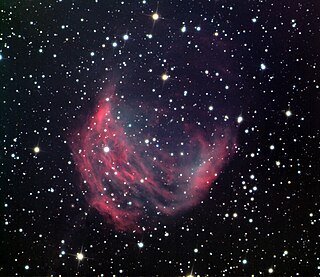
The Abell Catalog of Planetary Nebulae was created in 1966 by George O. Abell and was composed of 86 entries thought to be planetary nebulae that were collected from discoveries, about half by Albert George Wilson and the rest by Abell, Robert George Harrington, and Rudolph Minkowski. All were discovered before August 1955 as part of the National Geographic Society – Palomar Observatory Sky Survey on photographic plates created with the 48-inch (1.2 m) Samuel Oschin telescope at Mount Palomar. Four are better known from previous catalogs: Abell 50 is NGC 6742, Abell 75 is NGC 7076, Abell 37 is IC 972, and Abell 81 is IC 1454. Another four were later rejected as not being planetaries: Abell 11, Abell 32, Abell 76, and Abell 85. Another three were also not included in the Strasbourg-ESO Catalogue of Galactic Planetary Nebulae (SEC): Abell 9, Abell 17, and Abell 64. Planetaries on the list are best viewed with a large aperture telescope and an OIII filter.
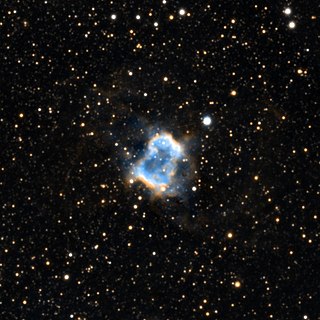
NGC 6445, also known as the Little Gem Nebula or Box Nebula, is a planetary nebula in the constellation Sagittarius. It was discovered by William Herschel on May 28, 1786. The distance of NGC 6445 is estimated to be slightly more than 1,000 parsecs based on the parallax measured by Gaia, which was measured at 0.9740±0.3151 mas.

IC 4997 is a planetary nebula located in the constellation of Sagitta. It was discovered in 1896 by Edward Charles Pickering and Williamina Fleming in 1896, and independently by Gustav Gruss in 1896. This nebula is about 14,000 light-years from Earth. It looks like an ordinary star in smaller telescopes, and only detailed study of its spectrum reveals its nebular characteristics.



















